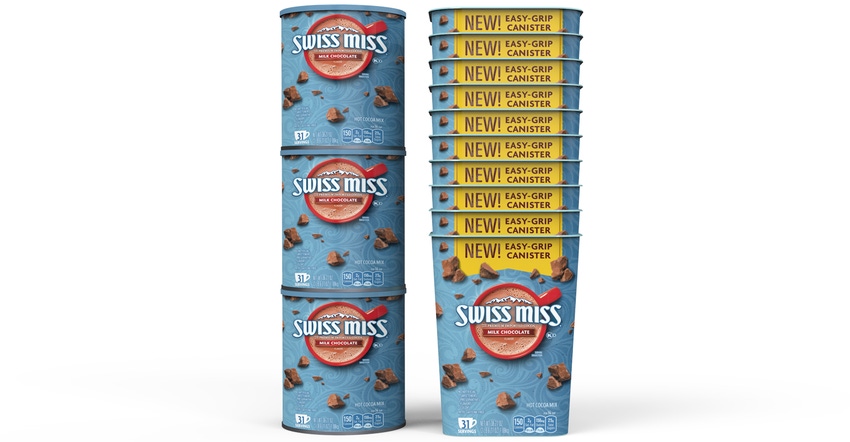Conagra Redesigns Packaging for Sustainability

Major packaged food company Conagra Brands is aiming to make 100% of its plastic packaging renewable, recyclable, or compostable by 2025, and its latest step in that direction is a new design for its bulk-size Swiss Miss hot cocoa containers. Created in partnership with supplier Berry Global's Blue Clover Studios, the new blue cannister, lid, and label of this formerly multilayered package is made completely of recyclable polypropylene (PP). The cannister has other sustainable design features – collectively these features will reduce carbon footprint associated with manufacturing and transporting by 15%, as determined by Berry Global's proprietary Carbon Footprint Calculator.
“We partnered with Berry to rethink what a 38-oz cannister for hot cocoa should look like, and we came to this product that is not only recyclable, but it’s a more space-efficient shape [a cube rather than round]; therefore less energy is required to transport them, and you can fit more on the shelves,” says Katya Hantel, senior director, Sustainability for Conagra Brands.
“So, it helps our retailers be more space efficient. And it drives a packaging solution consumers feel good about because when they are done with the cocoa they can put the container in the recycle bin, not the garbage can,” she says.
The big challenge was to create a more sustainable package while working on the structural look of the iconic Swiss Miss brand so that it was clearly recognizable to consumers of the cocoa, one of among roughly 100 brands manufactured by Conagra to include Birds Eye, Marie Callender's, Healthy Choice, Vlasic, and emerging brands like Earth Balance.
The technology for the Swiss Miss design includes an injection-molded container and injection-molded lid, which allows a reduction in package components. Additionally, the label is fused as part of the overall package during the injection process, eliminating the need for downstream label application equipment and reducing energy consumption, explains Scott Fisher, design director of Berry Global’s Blue Clover Studios.
By converting the entire container from a multimaterial package of fiberboard, metal, and plastic to a single, recyclable material, recyclers will not have to separate the label or lid. And there should be less contamination in the recycling stream, anticipate Berry and Conagra.
Not only is it anticipated that the new design will simplify recycling, but Fisher suspects many of the cannisters will continue to be reused because the rigid plastic is microwave and dishwasher friendly.
Additionally, because the cube has a tapered sidewall—narrower at the bottom than top—the containers can be stacked inside each other. This nestable design increases freight efficiency when transporting from supplier to the filler of the container. Ultimately, it will eliminate 1,000- plus gallons of diesel annually, according to Fisher.
The end product is the result of the work of a cross-functional team, brought together to understand the unique requirements of both the brand and package manufacturer.
“We have packaging engineers and brand leaders who looked at hot cocoa packaging, and in talking to our customers [retailers] we saw a need [for a more sustainable product]. So, the project originated with people who work on Swiss Miss every day, either on the packaging front or the brand side,” says Hantel.
On Berry’s end, the objective was to keep with the package designer’s vision and design intent while considering manufacturing processes.
“Brands want an identifiable concept that differentiates the brand and package from the competition. But as we work to do that, we have to consider packaging features that allow filling equipment to run the product on the line effectively,” says Fisher.
To ensure accomplishing the intention—that the product be recycled—– the cannister and lid are labeled as #5 indicating they are recyclable, and the standard How to Recycle label, recognized nationally, gives further instruction to help consumers understand where to place it at the end of life.
Conagra has for some time built sustainability into its business model, establishing four strategic pillars to guide operations:
Good food, which is about safety and nutrition;
Responsible, sustainable sourcing of packaging materials and sustainable ingredients;
Better planet, which is about greening manufacturing operations;
Stronger communities, which is about diversity, inclusion, and giving back.
With regard to the second pillar —sustainable packaging—among Conagra’s work, in June 2017 the brand launched a plant-based fiber bowl for single-serve frozen meals. This container replaces plastic trays that are not as easily recyclable.
“Swiss Miss is another example of us redefining what sustainability means. We look forward to continuing to develop packaging innovations that open new possibilities for recyclability in the food industry,” says Hantel.
The new package design for the 38-ounce Swiss Miss cannister is commercially available now.
About the Author(s)
You May Also Like




